关注记叙文描述性语言特色促进学生读写能力提升
苗梦娇

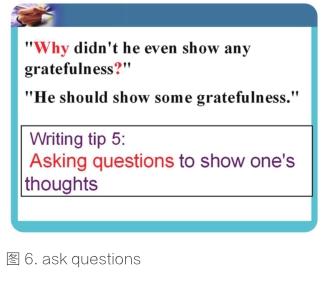

摘 要:本文以课例为载体,探讨了读写整合的课堂教学中,如何通过问题驱动,引导学生分析并模仿原文作者的写作特色,对人物进行动作、心理方面合理而生动的描写,从而使学生写出符合原文语言风格的续写段落,并树立学生使用描述性语言的意识,丰富描述性语言的语料库。
关键词:读后续写;描述性语言;以读促写;问题驱动
作为高考综合改革实验省份,浙江省的英语新高考出现了读后续写题型。读后续写要求学生在阅读文本后完成两段文字的续写,不仅需要学生在有限的时间内把握语篇结构进行符合原文逻辑、符合原文写作特色的创作,也对学生语言的丰富性提出了更高的要求。
从目前的两次高考真题来看,读后续写题型需要学生有一定的描写能力,例如环境描写、人物心理描写等。有的学生一遇到描写的部分就感到无话可说,或是为了凑满字数而写出偏离原文主旨的情节。例如2016年10月的英语高考续写题的第一段中,就有考生因不会使用描写性语言,而写出血染崖壁、遇到吸血鬼等离奇的情节。
这主要是由于在过去的写作体验中,学生使用的更多且更为习惯的是记叙性的语言,而缺乏描写性语言的积累和运用。这证明在平时的读写教学中,教师应改变固有的方式,引导学生关注描写性语言,并让学生练习描写、丰富语言,才能写出精彩的续写段落。
如何才能培养学生的描写能力,并让学生在短暂的时间内写出符合原文写作特色的文章呢?笔者选取了一个教学文本“The Cookie Thief”,设计了一堂读后续写课。
“The Cookie Thief”主要讲述了女主人公错将一名绅士当成无耻小偷的尴尬经历。全文没有一句对话,却将人物刻画得十分生动,读起来诙谐幽默,有很强的写作特色。
从续写段落的首句判断,续写的第一段应该用来描写女主人公发现真相后的心理活动,如果学生仅仅使用记叙性语言,就会感到这一段没有什么内容可以写。例如,有的学生只写了一句“The woman found the truth and felt embarrassed.” 之后便露出为难的神情,不知还能写什么了。
要解决这个问题,笔者决定尝试“借力打力”的方法。即在阅读中引导学生关注原文对于人物动作、语言、心理等方面的描写,强化学生的描写意识。其次,通过对原文几种描写手法的提炼,让学生在续写中模仿、运用、创新,让学生产出丰富而生动的描写人物心理的语言,丰富描写性语言语库,并让他们喜欢上描写。
课例背景
浙江省英语高考新增的读后续写题,不仅对学生的阅读能力和写作能力提出了更高的要求,对老师的读写课也提出了新的要求和挑战。浙江各地的英语教师都纷纷研究起了这一新题型,湖州市的各个学校也都开展了对“读写整合”课堂的探究。在这一背景下,湖州高中英语骨干班培训班的成员们在浙江师范大学教授和市教研员的带领下,在湖州二中开展了同课异构的市教研活动。笔者有幸参加了这一活动,并作为学院代表展示了一堂读后续写课。
教学内容与学情分析
1. 教学内容与整体设计思路
本课是一篇课外文本,是一个英国的智慧故事。文章讲述了一名女子在机场候机时,购买了一本书和一包饼干,当她边看书边吃饼干时,她发现坐在身边的男子正在厚脸皮地吃她的饼干,甚至连最后一块饼干都不肯放过。为了体现出她的良好教养,女子尽管很生气,却始终不开口阻止男子。登机后,女子惊讶地发现自己的饼干仍在包里,她吃的其实是男子的饼干。
故事剧情前后反转剧烈,给人以很强的冲击和教育意义,也很适合学生续写。作者对人物心理、动作的生动描写,则适合学生模仿与学习。
本课要在45分钟内,完成文本阅读,并当堂完成续写。笔者决定将教学中心定位在建立输入与输出之间的有效联系。每个环节都得直击主题,不能拖泥带水。因此导入部分就必须简洁,阅读部分要引导学生读重点,输出部分要培养学生描写的能力。输入与输出部分应各占整堂课的一半。
2. 学生情况分析
本课授课对象是湖州二中高二的学生,他们已经掌握了相当的词汇量,并做过一些读后续写的训练。在人教版《英语》(必修4)第4单元中,他们也已学习过身势语,明白不同的身势语能表达不同的心情。
在45分钟的课堂中,学生要完成文本的阅读与分析,讨论续写内容,并完成当堂续写,任务很重。考虑到高考读后续写就是要在短时间内完成输入与输出的过程,本堂课应将重点放在帮助学生在输入与输出之间两个过程之间架起直通的桥梁,引导他们准确、生动地输出。
教学目标
基于对教学内容和学生情况的分析,本课主要应完成以下学习目标:
1.语言知识和语言技能目标
(1)学生能正确使用关键词,并用关键词造句。
(2)学生能正确使用形容词、身势语、虚拟语气等方式描写人物心理活动。
(3)学生能理解文本,正确解读男女主人公的性格特点。
2. 学习策略目标
(1)学生能通过在原文中找出隐含信息的方式,判断续写部分是否符合原文的逻辑。
(2)学生能找出作者在描写人物内心时运用的写作手法,并在输出续写文本时模仿作者的写作手法,从而使得续写段与原文保持风格的一致。
3. 情感态度目标
(1)学生能通过阅读本文,探讨故事的结局,明白故事所要传达的生活哲理。
(2)学生能学会在小组活动中合作并相互欣赏。
(3)学生能树立在续写中使用描写性语言的意識,提高英语学习的兴趣。
教学准备
多媒体课件、教学文本、课堂学案
教学过程
Step 1: Lead-in.
教师向学生问好,通过学生脸上的表情了解学生此刻的心情,从而引入如何表达、描写心理活动的主题。师生对话如下:
T: Nice to meet you! I see you are all smiling. Does it mean you are welcoming me or like me?
Ss: Yes.
T: Although you didnt say a word, I can understand you just through your facial expressions, right? Are there other ways to express ones feeling? Today we are going to talk about “How to express ones feelings and thoughts”.
【设计意图】 通过简单的问好让学生意识到人们表达情感和思想的方式可以是多样的,从而为拓宽学生思维,让学生更好地描写人物的心理活动。
Step 2: Warm up with the key words.
教师展示与文本相关的图片,提供8个文中的关键词(woman, the plane, a packet of cookies, man, eat, think, rude, cookie thief),让学生根据图片,用关键词编一个故事。
师生对话如下:
T: We are going to read a story called“The Cookie Thief”. Before that, can you guess what happened according to the pictures and the key words? (见图1)
S1: A woman is waiting for the airplane and she is eating a packet of cookies. A man sitting beside her starts to eat the cookies too. The woman thinks the man is a rude cookie thief.
T: Good! In her story, who is the cookie thief?
S2: The man.
T: Now lets see if you are right by
reading the passage.
【设计意图】 此环节的目的是为了让学生猜测文章的内容,激发学生的阅读兴趣,为阅读做好准备,同时熟悉文中的划线词并初步使用划线词连词成句。Step 3: Reading for comprehension and writing skills.
(1)学生阅读文本第一段,快速找出故事发生的背景,如女子在飞机场的原因,女子当时的心情等,并找出第一种描写人物心情的方式——用形容词。师生对话如下:
T: Please read paragraph 1 and answer
my questions.
Ss read paragraph 1.
T: Where was the woman going?
S1: The woman was going to London.
T: Why was the woman going there?
S2: Because she got a new job there.
T: How was her new boss?
S3: It was said her new boss was a gentleman.
T: How did she feel about that?
Ss: Excited and nervous.
T: Now, here we can see that the writer uses adjectives to describe ones feelings.(見图2)
(2)学生在学案上记下第一种描写心情的手法(见表1)。
(3)学生读文本第2~3段,找出文中女子和男子的动作,并找出第二种描写人物心情的手法——使用身势语。师生对话如下:
T: Now lets see what happened next. Please read the second and third paragraphs and find out what the woman did and what the man did.
S1: The woman hunted for a book and bought a packet of cookies, took out the book and started to read.
S2: The man grabbed some cookies.
T: How did the woman respond to that?
S3: The woman just ignored it to avoid an argument. But she started to take cookies too.
T: Did the man stop?
S4: No, the man didnt stop grabbing the cookies.
T: Then what did the woman do in return?
S5: The woman munched some cookies and watched the clock.
T: Can you guess how she felt?
S6: She munched some cookies, so maybe she was angry.
S7: She watched the clock, which means that she was impatient.
T: So how did the writer show the womans feelings?
S8: Using body language.(见图3)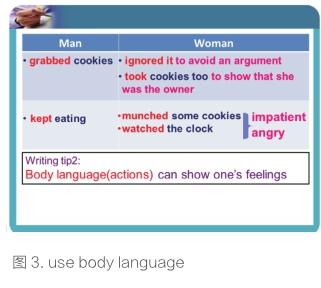
(4)学生在学案上记下第二种描写心情的手法(见表2)。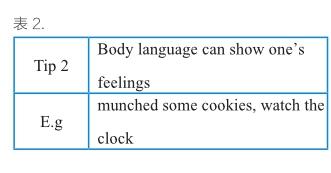
(5)学生读第4段,找出女子和男子的动作,并找出第三种描写人物心情的手法——使用虚拟语气。师生对话如下:
T: What did the woman think in this paragraph?
Ss: “If I werent so nice, I would blacken his eyes.”
T: Whats the meaning of “blacken ones eyes”?
S1: It meas “to beat somebody”.
T: Did the woman really beat the man?
Ss: No.
T: How do you know?
S2: This sentence is in the subjunctive mood.
T: Good! Now we see sentences in subjunctive mood can express ones wish.(见图4)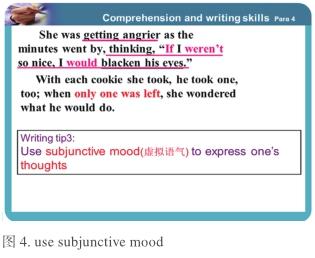
(6)学生在学案上记下第三种描写心情的手法(见表3)。
(7)学生阅读第五段,找出女子和男子的动作,并找出第四种描写人物心情的手法——描写面部表情。师生对话如下:
T: Now lets read paragraph 5 together and find out what the woman and the man did.
S1: The man took the last cookie with a smile and a nervous laugh, broke it in half and offered the last half to the woman.
T: What do you think of his behavior? If you were the man, would you take the last cookie?
S2: If I were the man, I would leave the cookie to the woman. The man was rude!
T: I guess the woman had the same opinion. So what did she do in return?
S3: The woman grabbed the last half and glared at the man.
教師向学生展示男子微笑的图片和女子怒视的图片。
T: Now look at these pictures. How did the writer describe their feelings and thoughts? (with a smile and a nervous laugh, glare at)
Ss: Facial expressions.(见图5)
(8)学生在学案上记下第四种描写心情的手法(见表4)。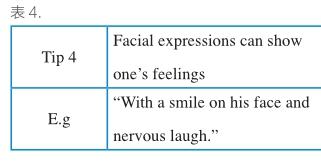
(9)学生找出描写女子想法的句子,比较问句和陈述句,判断哪种句子情感更强。从而获得第五种描写人物心情的手法——反问句。
T: What did the woman think?
Ss: “Oh, brother. This guy has some nerve and he is so rude! Why didnt he even show any gratefulness?”
T: Look at the last sentence. Why didnt the writer write it like “He should show some gratefulness”? Which sentence can express the womans thoughts better?
Ss: The question.
T: So we can see that sometimes asking questions can express ones thoughts.(見图6)
(10)学生在学案上记下第五种描写心情的手法(见表5)。
(11)学生读文章最后一段,了解故事的走向。师生对话如下:
T: What did the woman do at last?
S1: The woman sighed in relief, gathered her belongings and headed to the gate quickly.
T: What else?
S2: She refused to look back, boarded the plane, sank in her seat, and looked for her book.
T: How did the woman feel?
Ss: She felt angry and impatient.
(12)学生回顾整个故事,总结人物性格。师生对话如下:
T: Now lets go through the story again. Who was the cookie thief?
Ss: The man.
T: What do you think of the man?
S1: He was rude and selfish.
T: During the whole process, did the woman say a word?
Ss: No.
T: So what kind of woman do you think the woman was?
S1: She was well-educated.
S2: Although she was angry, she didnt argue with the man.
T: So maybe we can say the woman was a lady, right?
Ss nodded.
T: In conclusion, the man was the thief and the woman was a lady.
【设计意图】 此环节的设计是为了让学生了解故事内容,理清故事的开端、发展部分,找出作者写作特点,分析人物性格。为接下来的续写打好基础。Step 4: Preparing for writing.
(1)学生快速阅读续写两段的段首句(见图7)。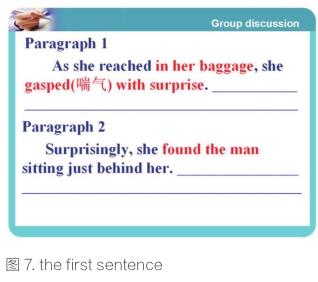
(2)学生讨论续写第一段的内容。师生对话如下:
T: Now lets look at the first paragraph you are asked to write. According to the first sentence, what did the woman do?
S1: She reached into her bag and gasped with surprise.
T: Why was she surprised? What did she find in her bag?
Ss: A packet of cookies!
T: Is it possible? How do you know it is a packet of cookies? Can you find any proof from the passage?
Ss read the passage quickly again.
S2: In paragraph 2, at first she bought a book and packet of cookies, but when she sat down, she only took out the book.
T: Yes. You are a careful reader! Now we know the womans cookies were still in her bag, so whose cookies did she eat?
Ss: The mans!
T: Now review what we thought about these two characters before. Now, do you still think it was the man who was the cookie thief?
Ss: No!
T: Then what kind of man he was?
Ss: A gentleman.
T: Why do you think so?
S3: Because although the woman was eating his cookies, he didnt get angry but even shared the last cookies with the woman.
T: Now do you still consider the woman a lady?
Ss: No! She was the cookie thief!
T: If you were the woman, how would you feel?
Ss: Embarrassed! Sorry! Guilty! Regretful!
T: So what should we write in this paragraph?
S4: We can write about her feelings and thoughts.
(3)学生讨论续写第一段的写作方法。学生共分4组,第1组讨论如何通过动作描写刻画女子心理,第2组讨论如何通过面部表情描写刻画女子心理,第3组讨论如何使用虚拟语气描写女子心理,第4组讨论如何使用反问句增强女子的情感。师生对话如下:
T: How to write about her feelings and thoughts? Can we write in the way the writer writes the story?
S1: Yes. We can use adjectives, subjunctive mood, write about her actions and facial expressions, and ask questions to stress the feelings.
T: Good. We have talked about the adjectives. Please have a discussion about how to write the womans feelings and thoughts in other 4 ways in groups.
(4)学生讨论结束后,由组长记录并向大家展示讨论成果,再将讨论成果书写到黑板上(见图8)。
学生具体板书如下:
Body language:
sat frozen, let out a slight cry, covered her face with her hands
Facial expression:
sitting there smiling embarrassed, her face turned red
Subjunctive mood:
1) If I had talked to the man directly, I wouldnt have been so rude and mean.
2) If I had checked my bag at first, I would not have made such a mistake.
3) I wish I hadnt been so rude.
Questions:
1) How would he think of me?
2) What happened?
教师展示图片和句型, 补充其他可以用来描写的内容,从而拓展学生思维,丰富学生语言,让学生的输出更多样(见图9)。
(5)學生讨论续写第二段的内容。师生对话如下:
T: What would the woman do in paragraph 2?
S1: She would apologize to the man and share the cookies with the man.
S2: She would talk to the man and they might become good friends or even get married.
S3: She would talk to the man and she finally found out that the man was her new boss.
T: Why do you think the man might be her new boss?
S3: In the first paragraph, it is said that her new boss was said to be a typical English gentleman.
T: Good guessing!
【设计意图】此环节让学生相互讨论,相互碰撞,从而拓展学生思维。写作方法的讨论让学生能关注人物心理的描写,从而为他们写出生动的文字打好基础。这个环节有利于学生最终的产出。Step 5: Writing.
(1)学生续写故事的最后两段。
(2)学生展示作品(见下页图10)。
【设计意图】此环节让学生将讨论的内容形成文字,进一步巩固所学的写作手法。分享优秀作品,让学生获得成就感,并相互学习。
Step 6: Conclusion and assignment.
学生讨论从故事中学到的道理,教师用一句哲理名言总结,并布置课后任务。 师生对话如下:
T: What have you learnt from the story?
S1: Sometimes we should not judge a person just according to what we think of them.
S2: We should be careful and be nice to others.
T: Id like to share a famous saying with you. “There is but one step from the sublime(高尚) to the ridiculous(荒谬)”. Hope you will be a wise man in your life.
T: Today we have learnt how to describe ones feelings and thoughts. The first assignment is that you need to polish what you have written. And to write well, you need to collect good expressions while learning. So another assignment, please reread our textbooks and set down some good descriptions.
1) When Li Fang thought Hu Jin didnt love him...
2) When Li Fang met Hu Jin near the coffee shop after he had thrown away her gifts...
3) When Roderick and Oliver were sure that Henry Adams was the right man...
4) When the owner of the restaurant found out that Henry Adams might be a millionaire...
【設计意图】 此环节是对文本的提升,让学生懂得我们在生活中对待他人应友好、耐心,不可武断。同时此环节也对整堂课学到的描写人物心理和情感的方法进行了回顾,并提醒学生们在平时的学习中多积累描写方法和好的表达。
教学反思
本课以智慧故事“The Cookie Thief”为文本,旨在让学生学习人物心理的描写方式。围绕教学目标,笔者进行了精心的设计。本课主要有以下三个亮点:
1. 问题驱动,有效阅读
以女主人公情感变化为轴线,教师对学生进行一环扣一环地提问,带领学生梳理出重点信息,引导学生关注文字所表达出的人物心理,读出文中的隐含信息。 问题链的方式使学生高效地把握故事走向,合理分析人物特征,为续写打好基础。
2. 以读促写,为续写搭起支架
本课的阅读部分除了帮学生梳理信息,掌握故事情节,还关注了作者在描写女主人公心理活动时所使用的描写手段,并精心挑选了形容词、肢体语言、表情、虚拟语气、反问这五个具有代表性的方法。这样一方面能有助于学生在续写中沿袭作者的写作风格,也较好地在学生的阅读和写作之间架起了桥梁。学生在续写时,可直接从这五个方面入手,丰富自己的描写语言,同时也增强了描写能力。
3. 小组合作,拓展思维
本课的写作环节中,学生通过小组讨论的形式,相互之间擦出了智慧的火花,从而拓展了写作思维,增加了课堂参与度和语言的丰富性。
总之,本课较好地达成了教学目标,让学生充分关注了描写性语言的运用,让学生有话可说,有话可写。提炼出的写作手法不仅在这一文本中可以使用,在其他文本中也能起到让学生语言生动起来的作用。同时,这堂课让学生增强了自信心,并提高了学习英语的兴趣。
本课的不足之处在于每位学生在课堂上只完成了一个续写段的写作。在评价方面,还须增加具体的评价标准,让学生在课后进一步相互交流。
通过这样一个案例,笔者尝试了如何“借力打力”,借助原文的写作手法,更有效地帮助学生在续写中产出更丰富生动而又符合原文写作特色的文字。这一方式能否运用到大部分读后续写练习中去,还须要进一步的实践和研究。
点评
读后续写作为一种全新的课型,目前还处于探索的起始阶段。苗老师敢于试吃螃蟹,挑战自我,在市级教研活动中开设读后续写公开课,供同行研究、探讨、评析,勇气可嘉。
纵观可见,本课教学思路清晰,学科核心素养指向明确,教师主导作用合理、到位,学生主体意识体现充分。具体来说,该课有以下几个特点:
一是理念新颖。45分钟的英语课堂一直以学生为主体,课内到处是对话和交流,师生间、生生间均有不同层次的互动。学生表达的机会多,合作探究的机会多,解决问题的机会也多。教师注重学生英语学科核心素养的培育,突出学生语言能力的训练,以及思维品质中分析、推理、想象和创造能力的提升。
二是选材合理。本课语言材料生动、有趣,话题能激发学生的兴趣,符合他们的认知水平。文本故事性强,情节跌宕起伏,男女主人公矛盾冲突明显,在内容上容易延伸,能给学生留下足够的想象空间,刺激学生的创作欲望。给定的阅读部分语言易模仿,生词、难句适度,有利于学生顺利阅读和准确理解。
三是设计巧妙。苗老师以问题驱动的方式,按照文本女主人公的情感变化为主线,层层推进教学,让学生在互动活动中产生思维火花的碰撞,课堂因此变成了思维训练场。同时,几十个问题连成的问题链也真正起到了引导学生走入文本,深入阅读的功效,达到充分理解的程度。再者,苗老师在引导学生解读文本时,还有意借助表格等形式,来帮助学生充分挖掘男女主人公的人物性格。这样的解读方式条理清晰,对比明显,为后续两位主人公位置转换后的续写内容定下了基调。此外,整堂课以“说—读—说—写”的方式来安排学生活动,保证学生有足够输入后再进行有效输出。
四是生成有效。课堂的生成是否有效很大程度上取决于教师课前的教学设计和课内的临场引导。苗老师虽然是借班上课,与学生第一次接触。但她优良的语言面貌和亲切大方的教态拉近了与学生的距离。导读文本时有意识地提炼出形容词、肢体语言、表情、虚拟语气、反问五个描写手段,为学生下阶段的续写提供了参照。在学生续写前,组织学生充分讨论续写部分的情节和语言,为写作搭建了必要的支架。组织写作时,又指导学生以小组互助的形式来完成,有效降低了写的难度。另外,在写前讨论阶段,邀请学生代表上黑板板书不同的表达方式,增加了学生的竞争意识和成就感。以上因素促成了本课的有效生成。
总之,本课教学目标明确,导读方式多样,支架搭建有效,策略指导到位,达成了读写结合、以读促写的教学目的。它是一次成功的尝试,为同行们研究如何在课堂内实现读写联动、以读促写提供了借鉴。

